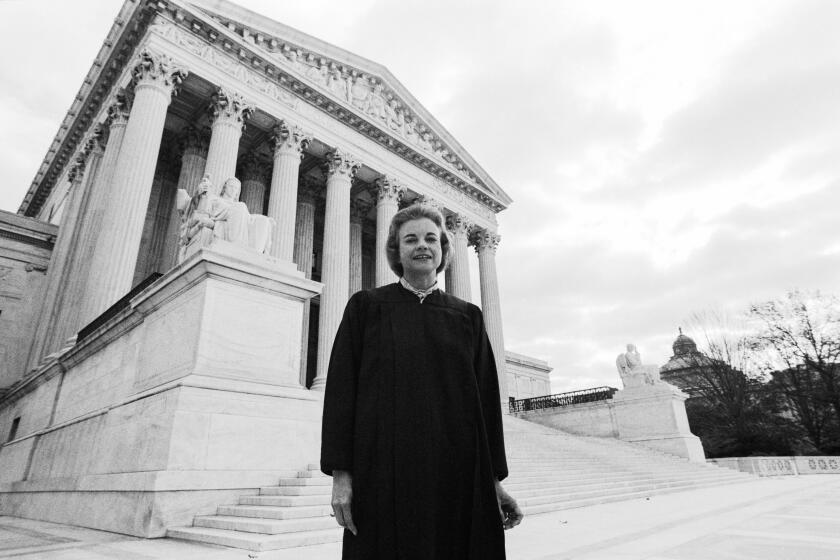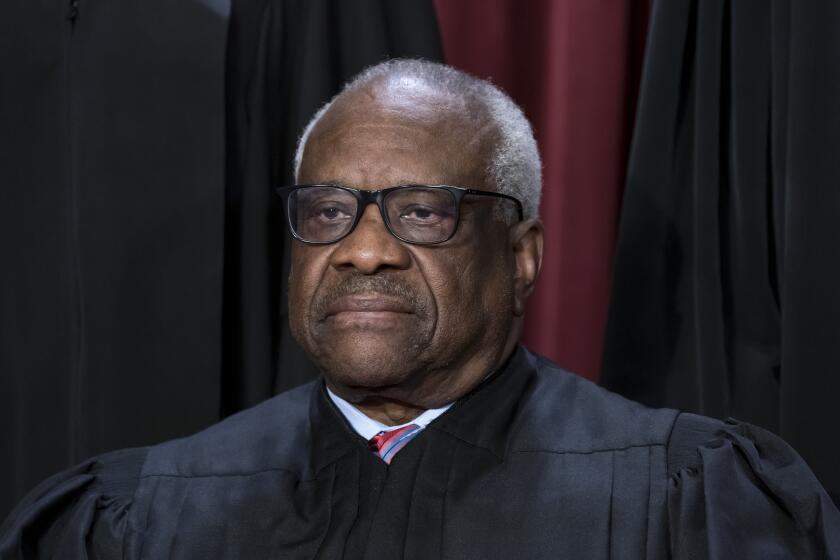The late Sandra Day O’Connor, the first woman to serve on the Supreme Court, honored as trailblazer

- Share via
WASHINGTON — Justice Sandra Day O’Connor, the first woman to serve on the U.S. Supreme Court, was remembered Monday as a trailblazer who never lost sight of how the high court’s decisions affected all Americans.
O’Connor, an Arizona native who was an unwavering voice of moderate conservatism for more than two decades, died Dec. 1 at 93. Mourners at the court on Monday included Vice President Kamala Harris, the first woman to serve in her role, and her husband, Doug Emhoff.
Supreme Court Justice Sonia Sotomayor spoke at a private ceremony that included the nine justices and retired Justice Anthony Kennedy, as well as O’Connor’s family and court colleagues.
“She would often say, ‘It was good to be the first, but I don’t want to be the last,’” Sotomayor said of O’Connor’s distinction as the first woman on the high court. She lived to see a record four women serving on the court at the same time — Sotomayor, Elena Kagan, Amy Coney Barrett and Ketanji Brown Jackson.
“For the four us, and for so many others of every background and aspiration, Sandra was a living example that women could take on any challenge, could more than hold their own in any spaces dominated by men and could do so with grace,” Sotomayor said.
O’Connor’s body lay in repose after her casket was carried up the court steps with her grandchildren serving as honorary pallbearers. It passed under the iconic words engraved on the pediment, “Equal Justice Under Law,” before being placed in the court’s Great Hall for the public to pay their respects.
Funeral services are set for Tuesday at Washington National Cathedral, where President Biden and Chief Justice John Roberts are scheduled to speak.
Retired Supreme Court Justice Sandra Day O’Connor has died at age 93. She was the first woman to ascend to the high court.
O’Connor was nominated in 1981 by President Reagan and confirmed by the Senate, ending 191 years of male exclusivity on the high court. A rancher’s daughter who was largely unknown on the national scene until her appointment, she received more letters than any other member in the court’s history in her first year and would come to be referred to by commentators as the nation’s most powerful woman.
O’Connor had “an extraordinary understanding of the American people,” and never lost sight of how high court rulings affected ordinary Americans, Sotomayor said.
She was also instrumental in bringing the justices together with regular lunches, barbecues and trips to the theater. “She understood that personal relationships are critical to working together,” the justice said.
O’Connor wielded considerable influence on the nine-member court, generally favoring states in disputes with the federal government and often siding with police when they faced claims of violating people’s rights. Her impact could perhaps best be seen, though, on the court’s rulings on abortion. She twice helped form the majority in decisions that upheld and reaffirmed Roe vs. Wade, the decision that said women have a constitutional right to abortion.
Thirty years after that decision, a more conservative court overturned Roe, and the opinion was written by the man who took her place, Justice Samuel Alito.
Supreme Court Justice Clarence Thomas is acknowledging that he took three trips last year aboard a private plane owned by Republican megadonor Harlan Crow.
O’Connor grew up riding horses, rounding up cattle and driving trucks and tractors on the family’s sprawling Arizona ranch and developed a tenacious, independent spirit.
She was a top-ranked graduate of Stanford’s law school in 1952, but quickly discovered that most large law firms at the time did not hire women. One Los Angeles firm offered her a job as a secretary.
She built a career that included service as a member of the Arizona Legislature and a state judge before her appointment to the Supreme Court at 51.
When she first arrived, there wasn’t even a women’s bathroom anywhere near the courtroom. That was soon rectified, but she remained the court’s only woman until 1993.
“She changed something,” said Karen DiMario, 62, of Lake Forest, Ill., who came to pay her respects with her husband, Joe DiMario, 63. O’Connor’s life and experiences brought an important perspective to the court that had long been lacking, and her centrist reasoning had strong legal, rather than political, underpinnings, the couple said.
O’Connor retired at 75, citing her husband’s struggle with Alzheimer’s disease as her primary reason for leaving the court. John O’Connor died three years later, in 2009. After her retirement, she expressed regret that a woman had not been chosen to replace her.
She remained active, sitting as a judge on several federal appeals courts, advocating for judicial independence and serving on the Iraq Study Group. President Obama awarded her the Presidential Medal of Freedom, the nation’s highest civilian honor.
She died in Phoenix, of complications related to advanced dementia and a respiratory illness. Her survivors include her three sons, Scott, Brian and Jay, six grandchildren and a brother.
The family has asked that donations be made to iCivics, the group she founded to promote civics education.
The last justice who lay in repose at the court was Ruth Bader Ginsburg, the second female justice. After her death in 2020, during the COVID-19 pandemic, mourners passed by her casket outside the building, on the portico at the top of the steps.
More to Read
Sign up for Essential California
The most important California stories and recommendations in your inbox every morning.
You may occasionally receive promotional content from the Los Angeles Times.















